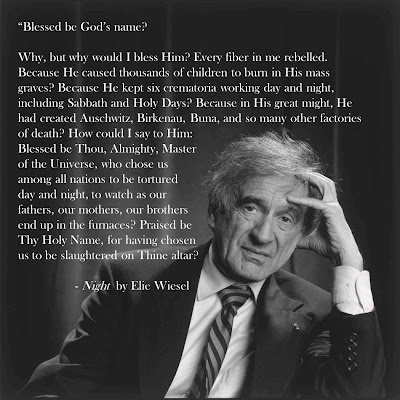 Aim:
Aim:IWBAT compose a four-paragraph expository response to literature that describes how Eliezer Wiesel is a dynamic character in Night.
- Monday: overview, prewrite, and draft body paragraphs
- Tuesday: draft introduction & conclusion paragraphs
- Wednesday: finish drafting
- Thursday: revise & edit
- Friday: no ELA class
Key Points:
1. A dynamic character changes (in a big way) during the course of the story, whereas a static character stays the same.
2. A response to literature is writing that shows your understanding and interpretation of literature.
3. Revising is literally "seeing again." When we revise our writing, we make changes to the way we express our ideas to make them clearer, more interesting, and more convincing.
4. Editing is correcting errors in conventions. CUPS is a useful acronym to list the things we edit for: Capitalization, Usage/grammar, Punctuation, and Spelling.
Project Overview:
- FORMAT an expository response to literature (essay)
- AUDIENCE Mr. T and my teammates
- ROLE an awesome, articulate sixth grade writer (myself)
- TOPIC how Elie Wiesel is a dynamic character in Night
Tasks:
1. Do Now: Prepositions and Homework Check
2. Prewrite
- Make a copy of this document into your Google Drive to use for your prewriting and drafting.
- View prewriting and drafting resources on paper here.
3. Draft
- You can view an exemplar for this assignment here. (Note, this exemplary essay focuses on Vladek Spiegelman from Maus, rather than Elie Wiesel from Night.)
- View other drafting resources here.
- While in your Google document, click Share in the upper-right corner of the window.
- In the dialogue box, click Change under Who Has Access.
- Select Can comment from the drop-down list.
- Click Save.
- The web address for your essay should already be highlighted (under Link to share). Press CTRL + C to copy the web address.
- Click Done.
- Open this Google form.
- Type in your first and last name and select your homeroom.
- Then, paste your the web address to your essay by pressing CTRL + V.
- Click Submit.
5. Revise
- Practice revising Mr. T's paragraphs:
- The Google document is read-only, so you must copy it into your own Google Drive and save it as your own document in order to make changes:
- Select the link above.
- Click Make a Copy under the File menu.
- Type in the name of your file to be saved: "Adding Details Practice."
- Click OK.
- Your copy of Mr. T's document will open in a new tab, and you can start revising.
- Track Mr. T as he demonstrates how to revise by adding details to writing.
- Revise Mr. T's paragraph by adding details, using the same procedure Mr. T just demonstrated.
- You will now revise your response to literature by adding details, using the same procedure.
- Next, revise your writing by adding direct quotes to your essay.
- Use a book to find passages to use for evidence in both body paragraphs.
- Write down a passage word for word and put it in quotes.
- Be sure to state which page number it comes from.
- For example, you could write: On page 34 in Night, Elie Wiesel writes, "Never shall I forget those flames that consumed my faith forever."
- you have capitalized the first word of each sentence
- you have a punctuation mark at the end of each sentence
- there is a space after each period and each comma
- you have indented each paragraph using the TAB key
- you have skipped to next line when starting a new paragraph
- there are no misspelled words (no words with squiggly red line underneath)
7. Finished Early? Complete these activities:
- Read a teammate's response to literature and make comments to suggest how he/she could add details to improve the clarity and interest of writing:
- Open this spreadsheet with links to your teammates' essays.
- Find your partner's name and click the link to his/her education essay. (And click it again.)
- Your partner's response to literature should open in a new tab.
- You can now read your partner's essay and make comments on it.
- To make a comment, select the part of the text that you want to comment on and click Comment under the Insert menu. You can also push CTRL + ALT + M.
- Help your partner improve his/her response to literature by suggesting places and ways to add details to the writing.
- It's okay to make other compliments and suggestions, but focus on adding details.
- If you finish early, help another teammate by reading and commenting on it.
- Read about Elie Wiesel and his foundation on their website.
- Read Elie Wiesel's Nobel Peace Prize acceptance speech here.
- Watch these videos:
- Elie Wiesel with President Obama, outside Buchenwald: click here
- Elie Wiesel discussing his view on forgiveness: click here
- Oprah's interview with Elie Wiesel at Auschwitz: click here
- Read an independent reading book
- Complete today's activity on TeenBiz3000
Homework:
- Monday: draft two body paragraphs (pages 4-5 of packet)
- Tuesday: draft introduction and conclusion (pages 3 and 6 of packet)
- Wednesday: Figurative Language in Night + finish drafting response to literature
- Thursday: The Holocaust Defined + finish final draft of response to literature (on Google Drive)
- Friday: Winter Break Packet (education essay)
- Read previous winning contest entries here (including some written by KBA students!)

No comments:
Post a Comment